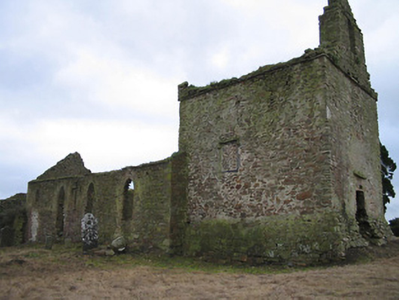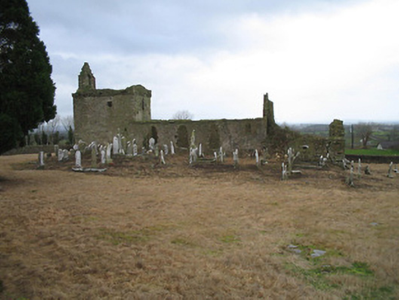Survey Data
Reg No
12403004
Rating
Regional
Categories of Special Interest
Archaeological, Architectural, Artistic, Historical, Social
Original Use
Church/chapel
Date
1740 - 1760
Coordinates
241852, 139098
Date Recorded
29/11/2004
Date Updated
--/--/--
Description
Detached six-bay single- and two-storey Catholic chapel, c.1750, incorporating fabric of medieval church, c.1500, on site comprising four-bay single-storey nave with single-bay two-stage entrance bay to west on a square plan, and remains of single-bay single-storey range to east. Restored, 1818. Decommissioned, post-1896. Disused, 1903. Now in ruins. Pitched slate roofs now gone with rubble-stone bellcote to west (with rubble stone piers on a stepped base flanking camber-headed opening having dressed rubble stone voussoirs, bell now missing, and rubble stone stepped parapet), and no rainwater goods surviving on dressed rubble stone eaves. Random rubble stone walls (mostly collapsed to range to east) with slight batter to base to entrance bay, and dressed stone quoins to corners. Pointed-arch window openings to nave with no sills, red brick dressings, and no fittings surviving. Outline of square-headed window openings to entrance bay with one having cut-limestone sill, one having cut-limestone surround incorporating mullion forming bipartite elliptical-headed arrangement, hood moulding over, and random rubble stone infill. Square-headed door opening with no fittings surviving. Set back from road in own grounds. (ii) Graveyard to site with various cut-stone markers, c.1750-pre-1903.
Appraisal
A modest-scale chapel representing an important element of the architectural heritage of Coolaghflags and the environs on account of the status as one of the earliest surviving ecclesiastical centres in the locality: incorporating the fabric of a medieval range on site a mid eighteenth-century chapel remained in use until superseded by a larger church (12403003/KK-30-03) in the late nineteenth century. Although having fallen into ruins the original composition attributes survive largely intact including the essential characteristics differentiating the two periods of construction. An attendant graveyard containing a collection of markers of artistic importance displaying high quality craftsmanship enhances the group and setting values of the site in the landscape.



